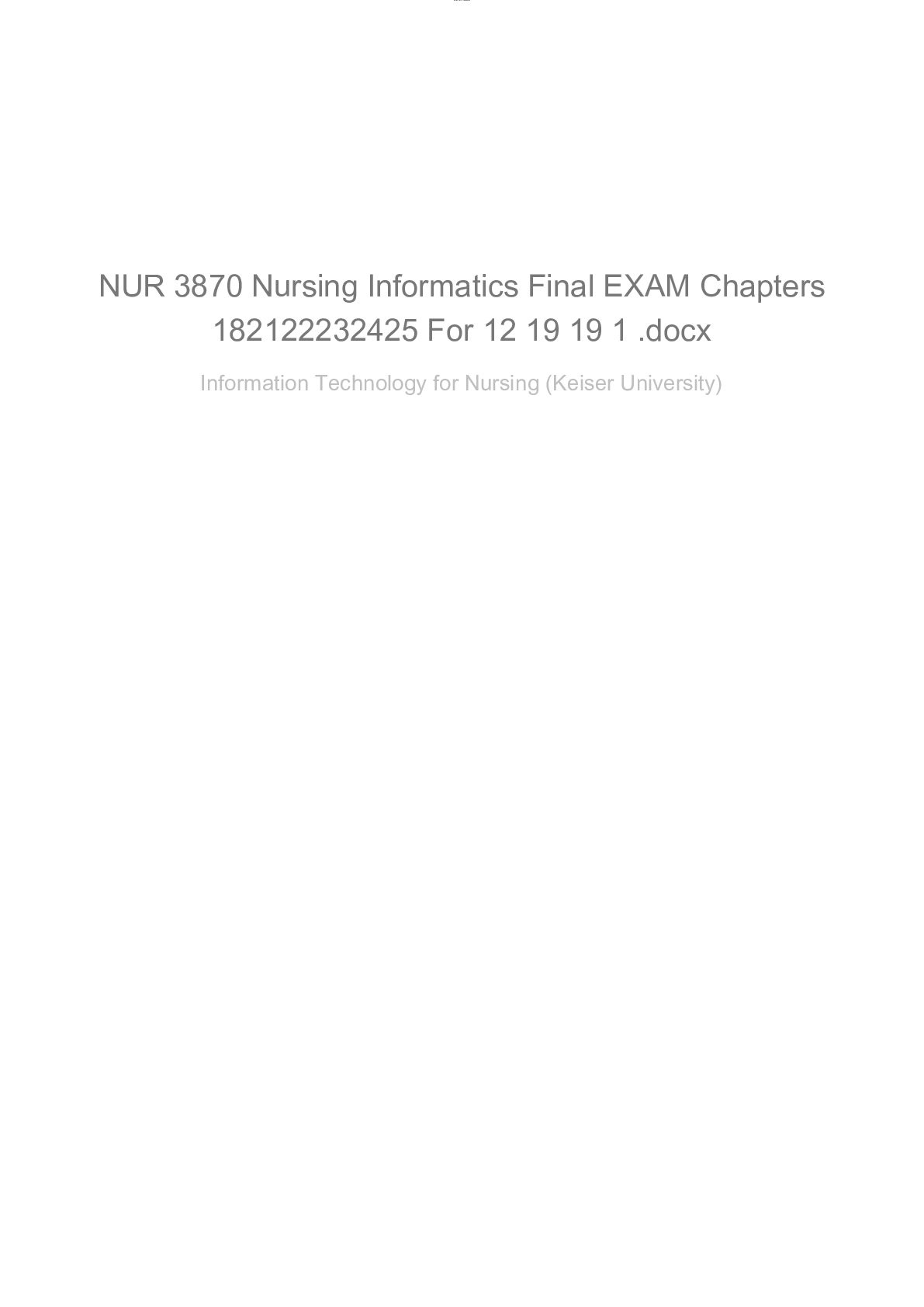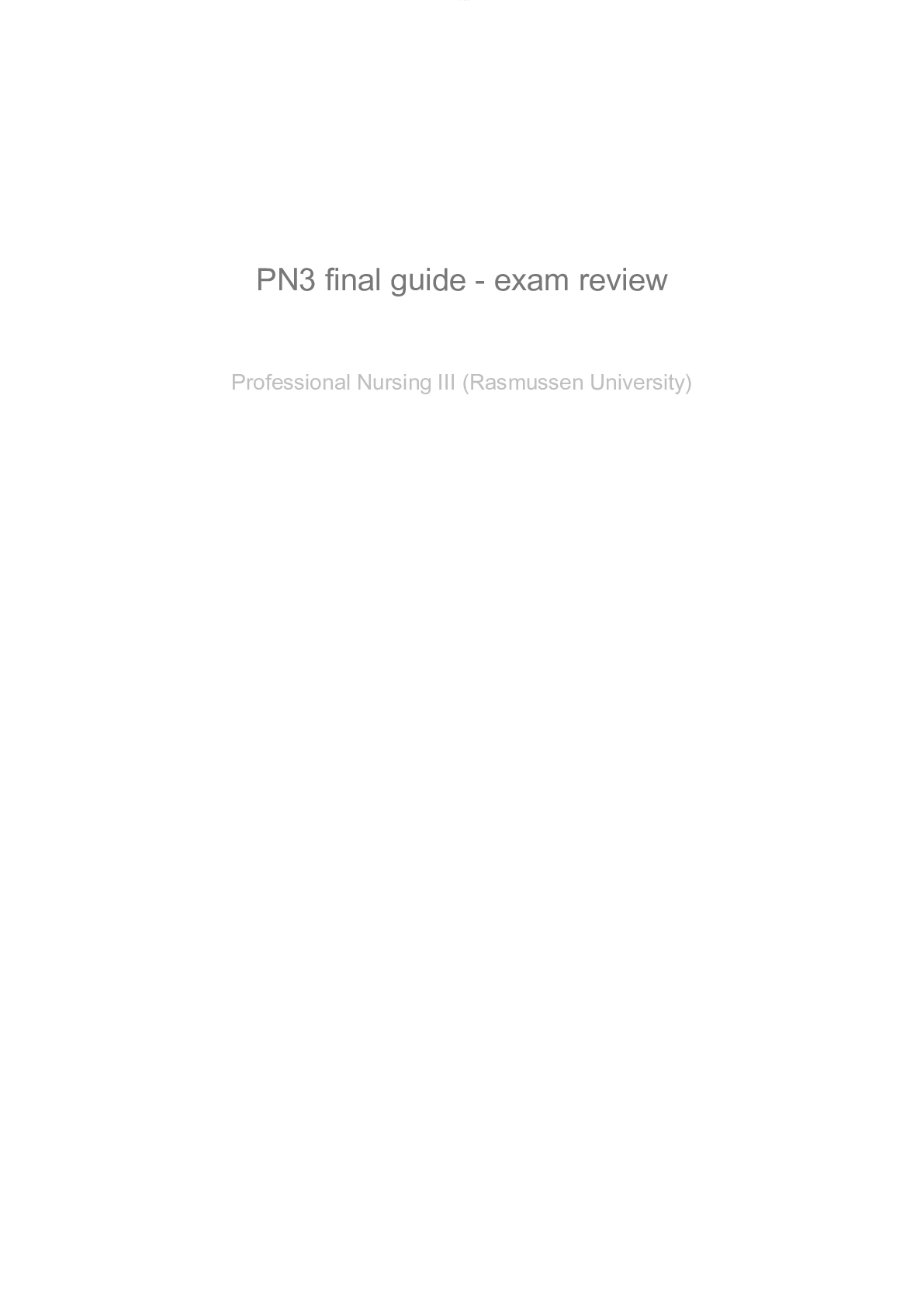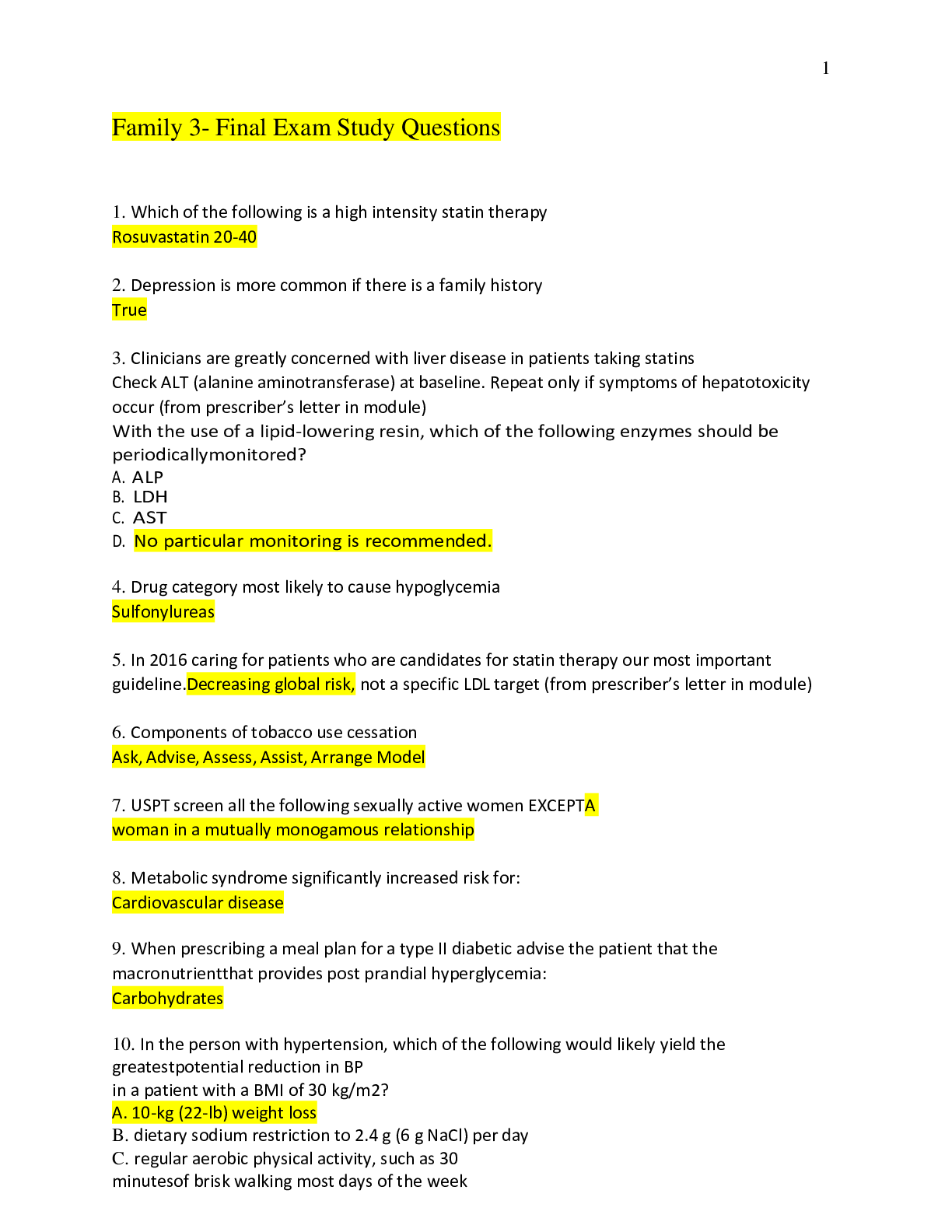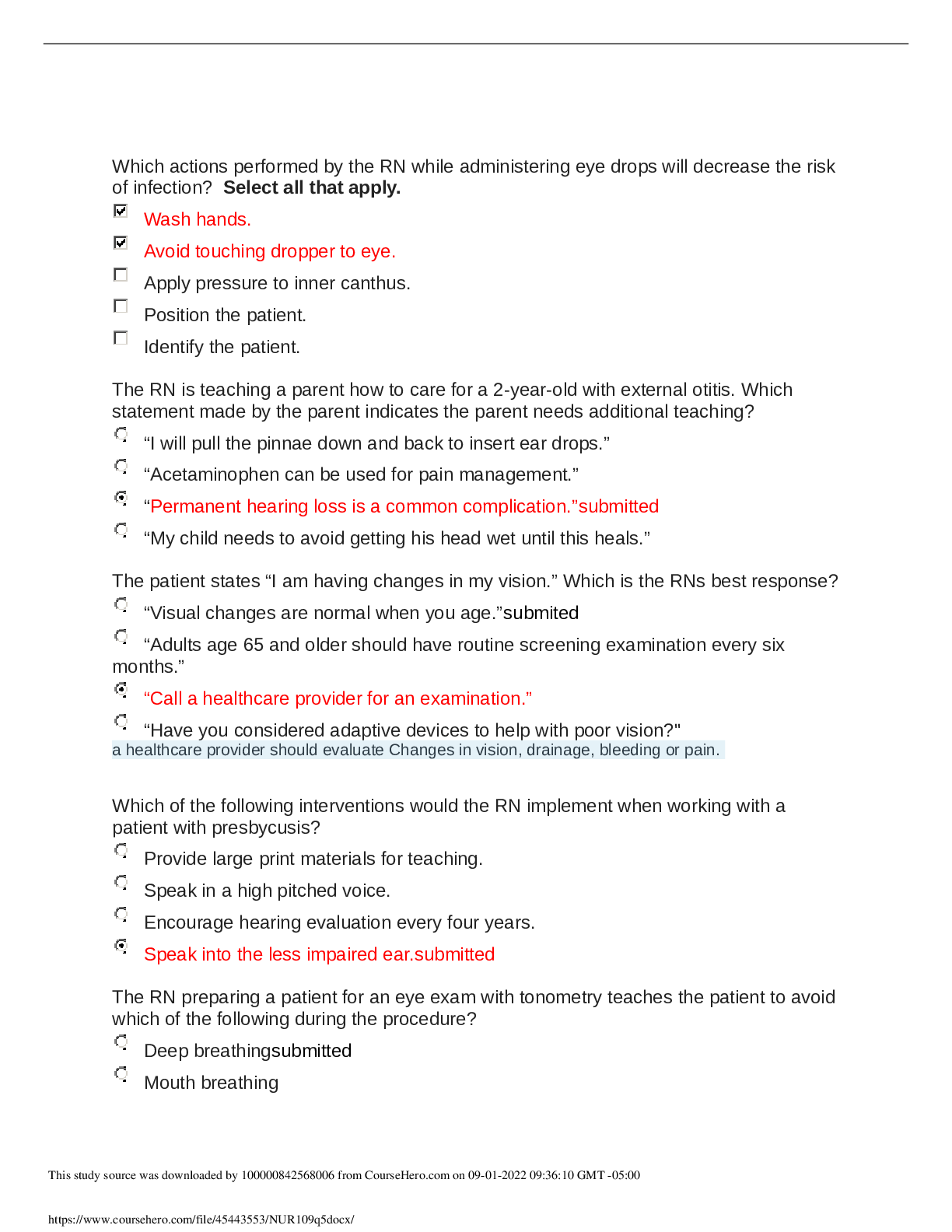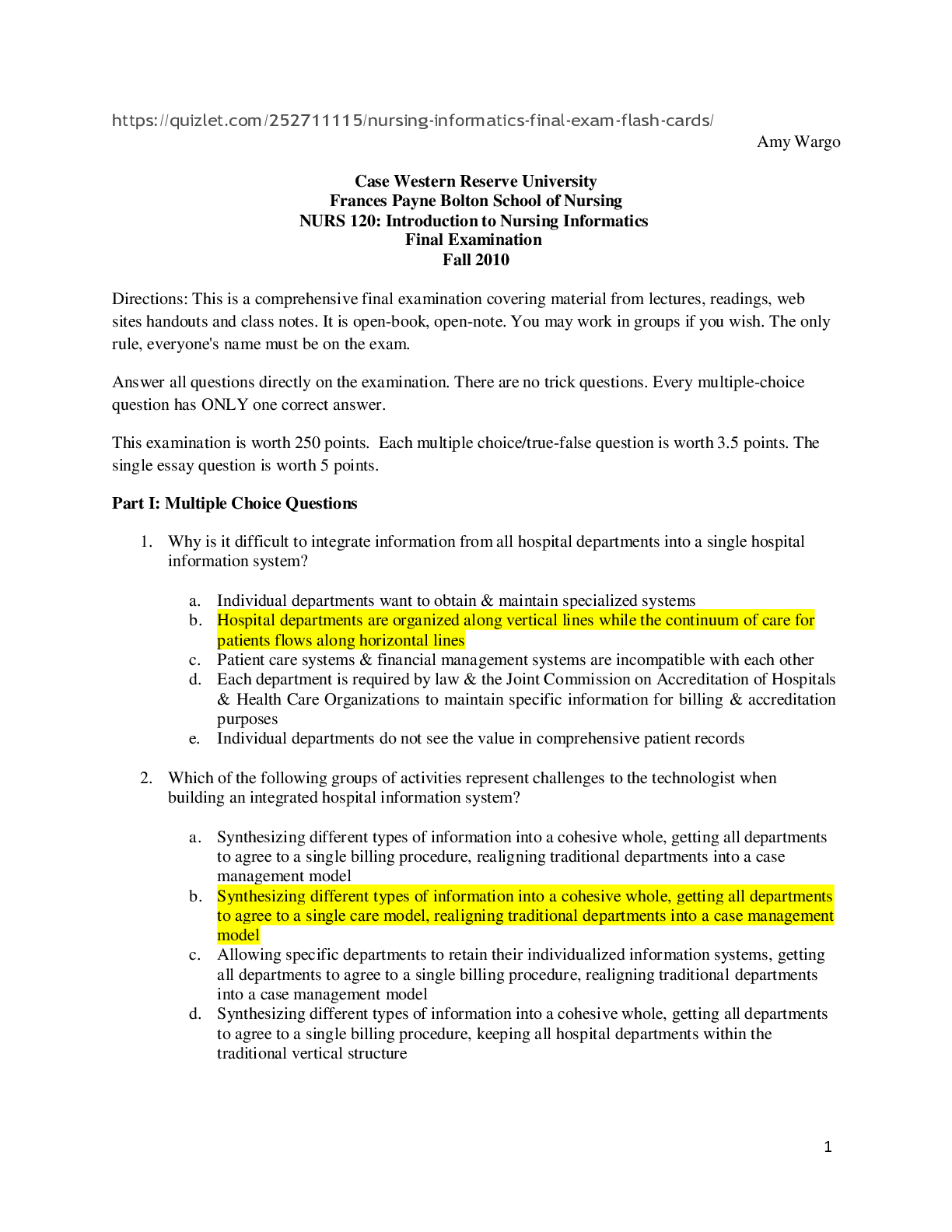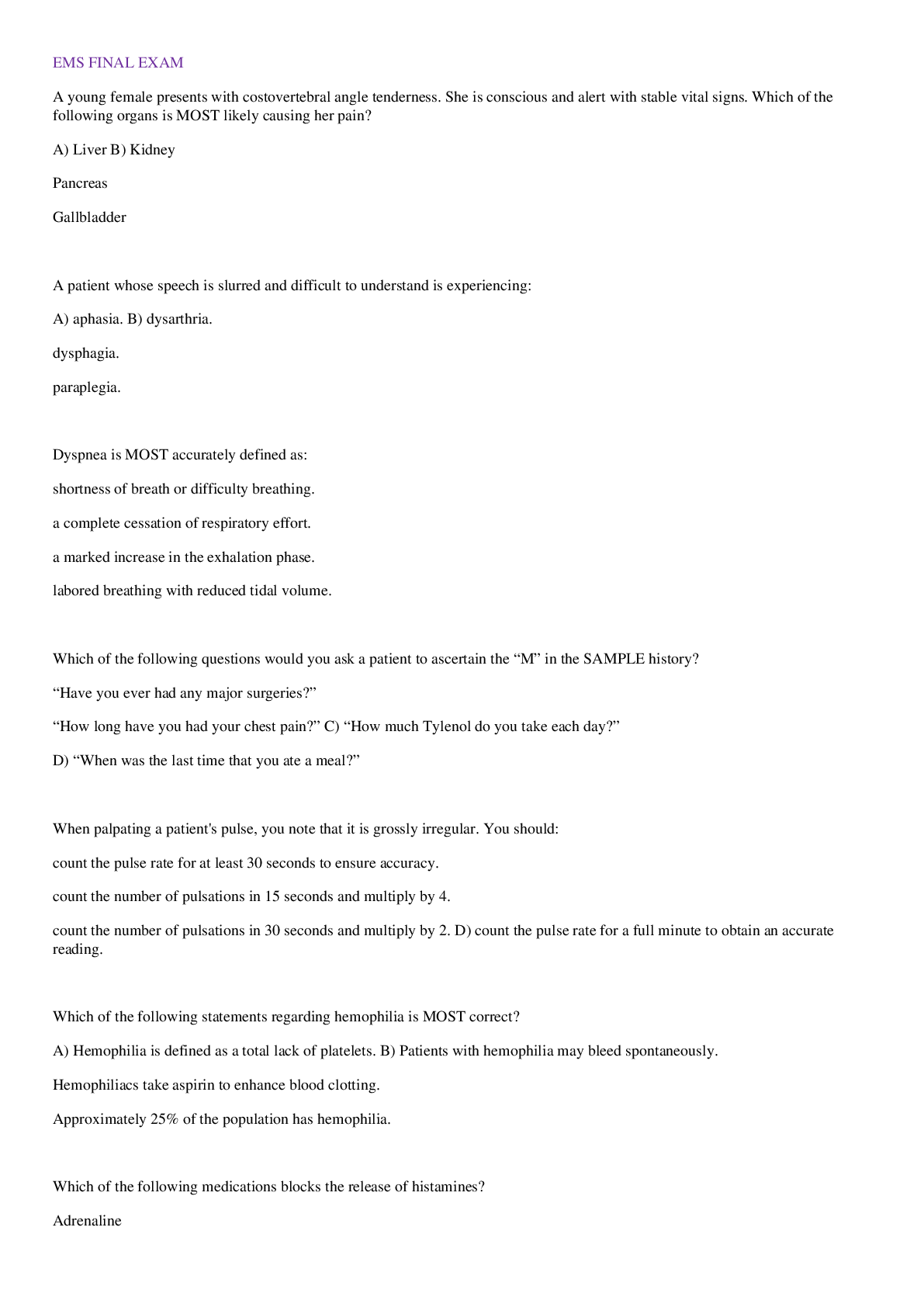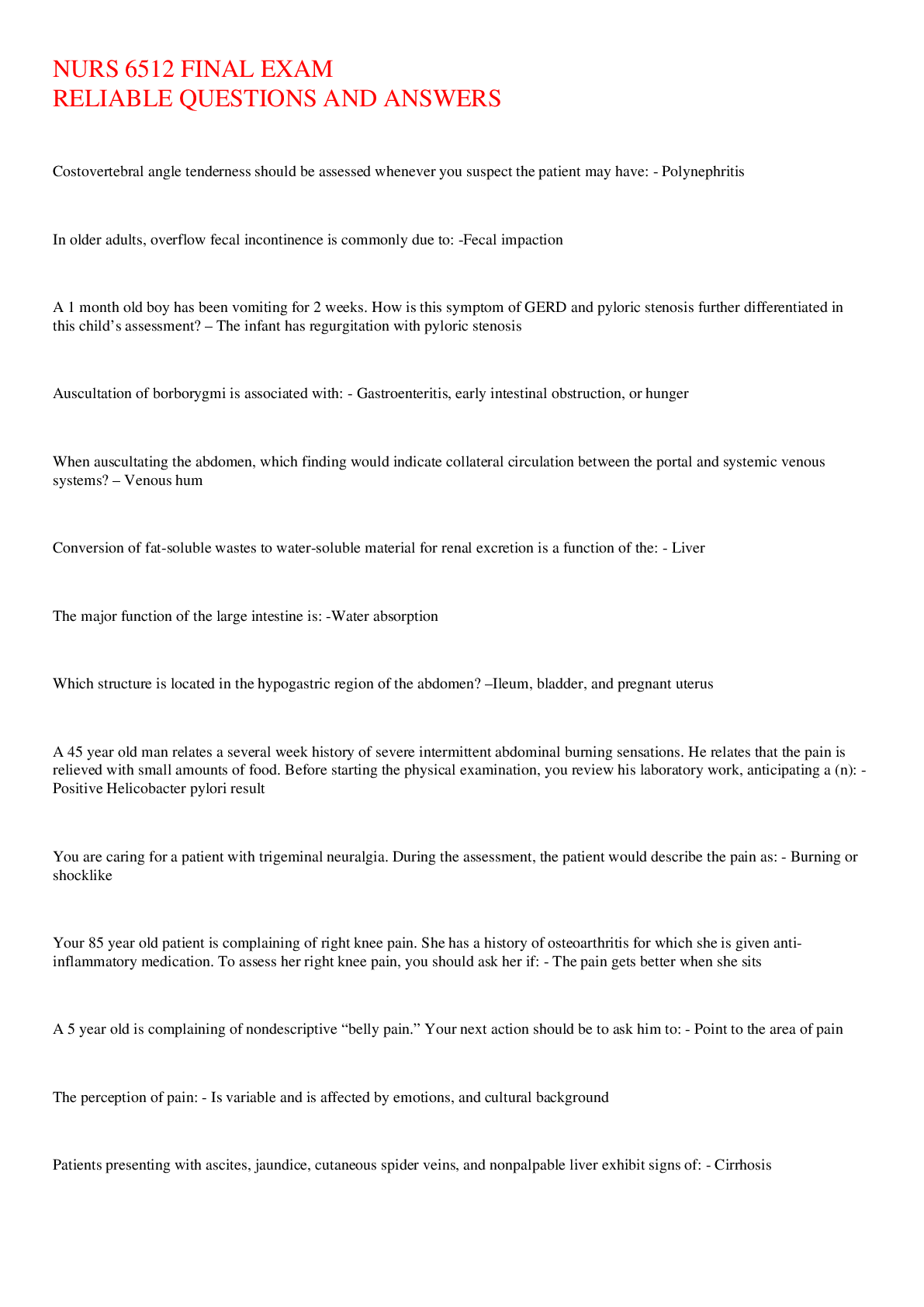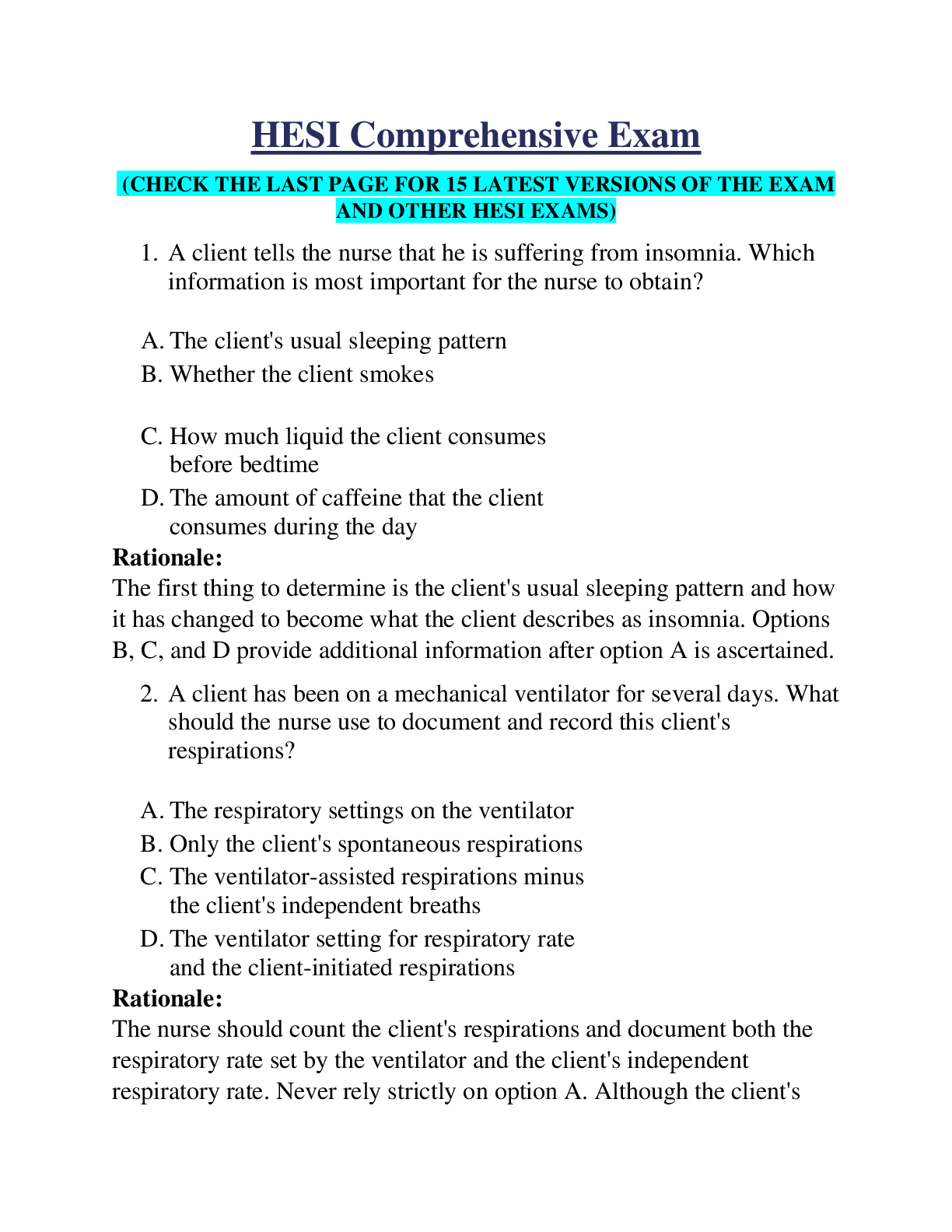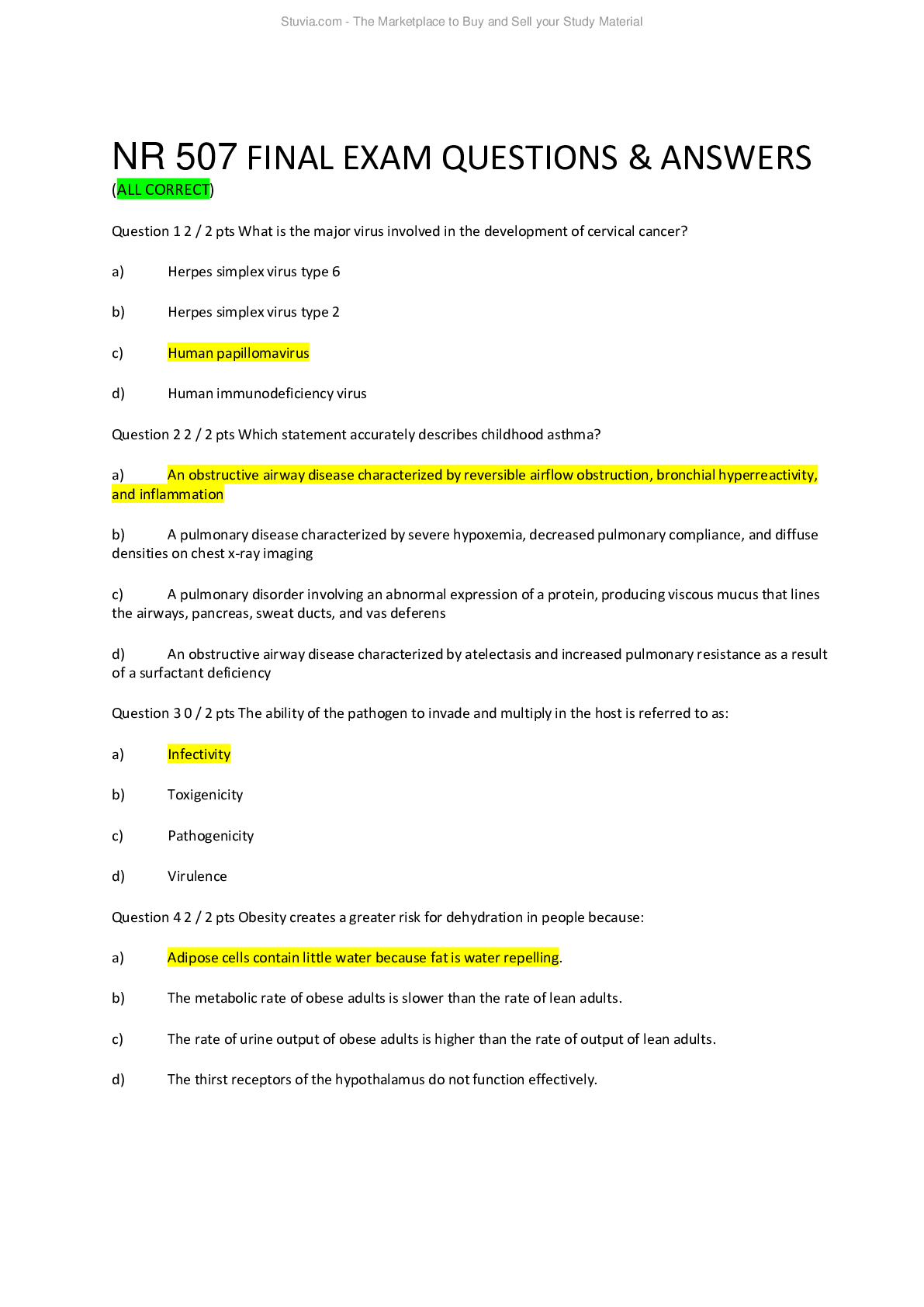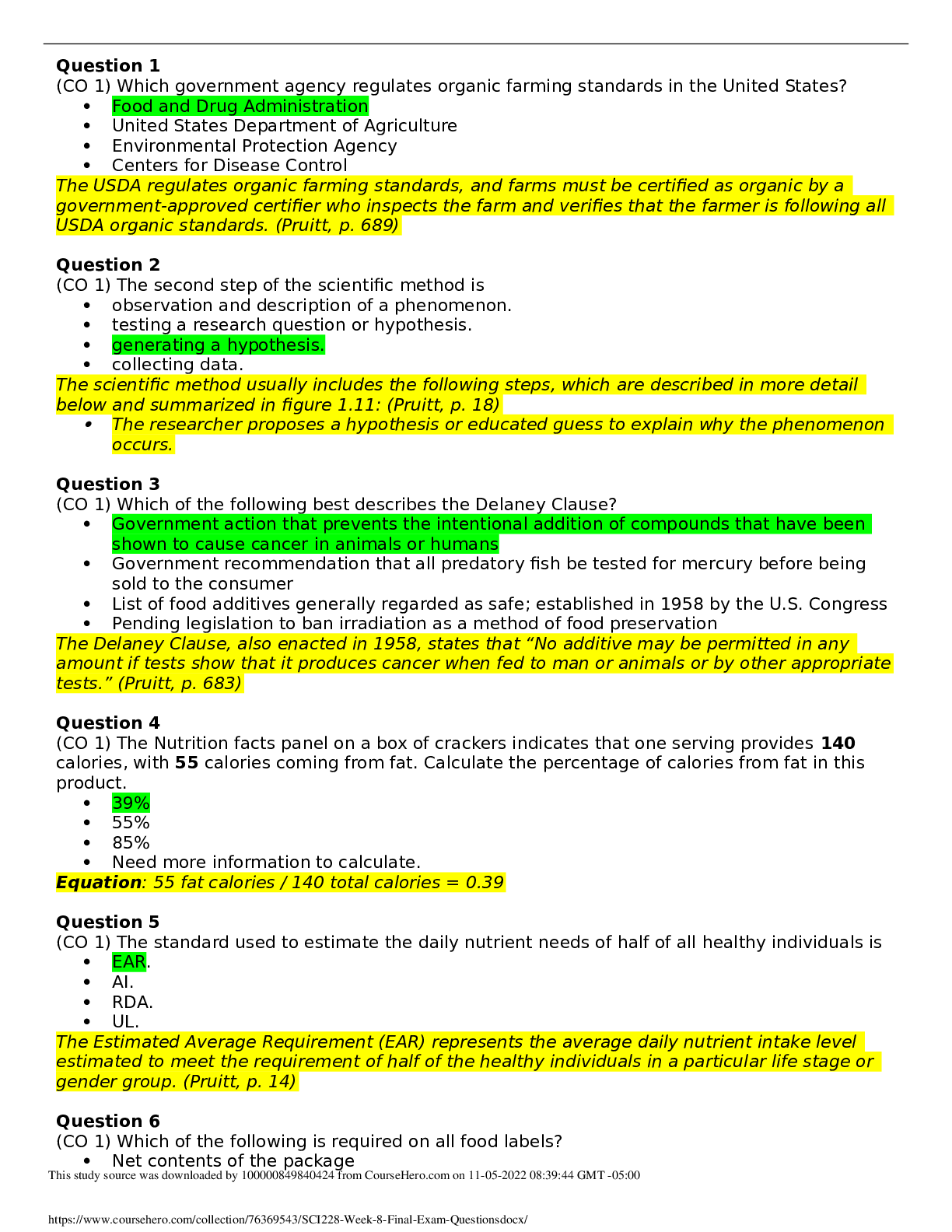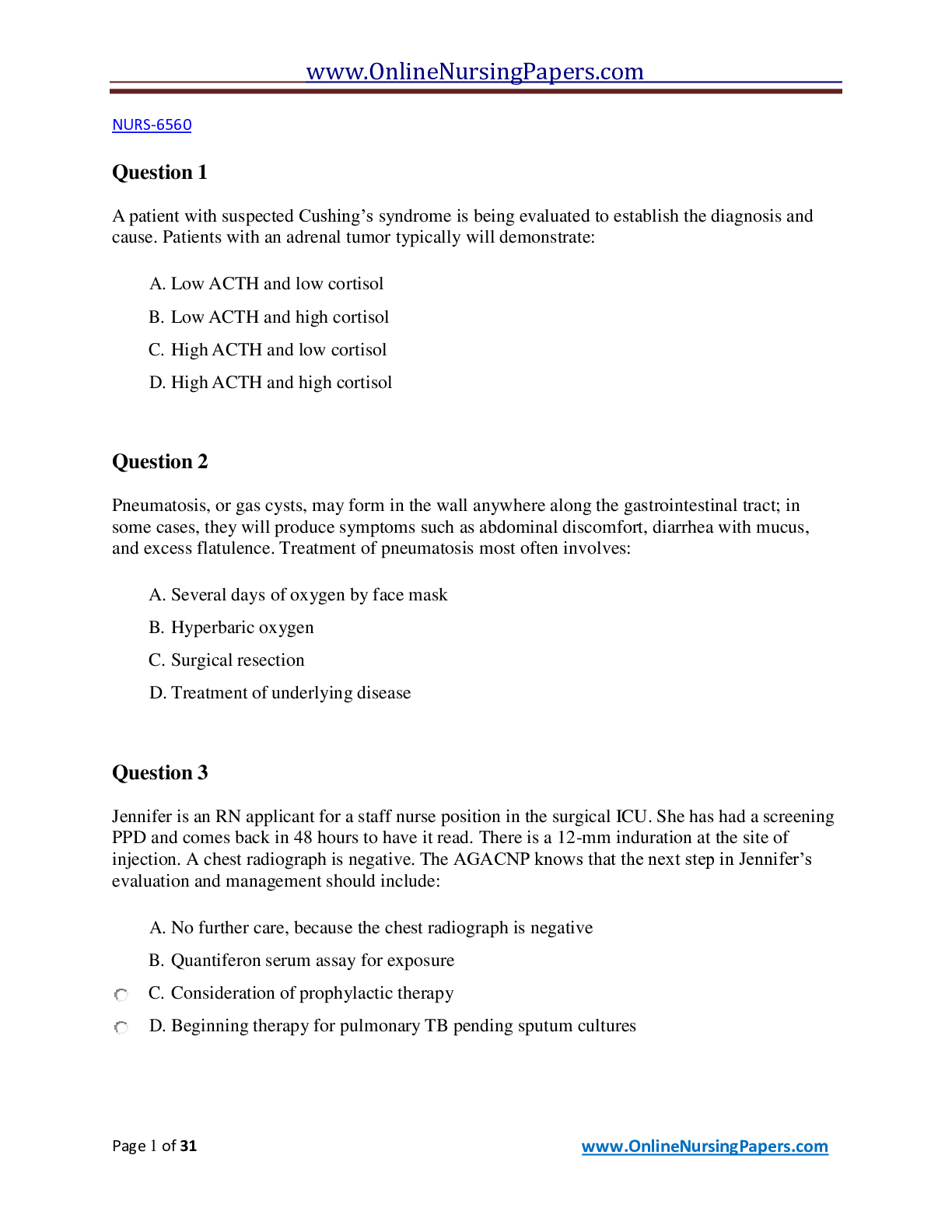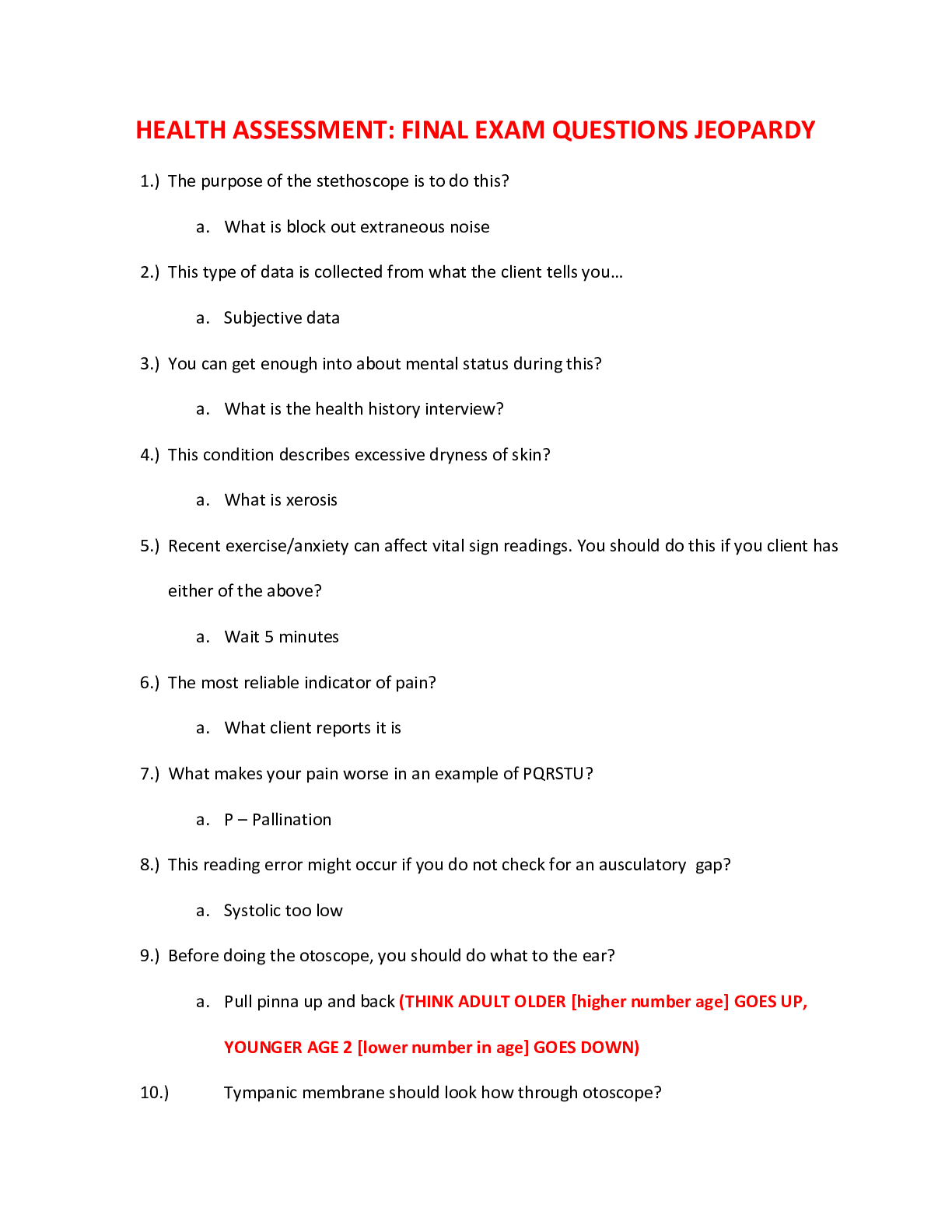*NURSING > Final Exam Review > NURS 6660 Final Exam questions with answers (All)
NURS 6660 Final Exam questions with answers
Document Content and Description Below
Question 1 In which demographic is depression twice as prevalent in girls as compared to boys? A. Preschoolers B. School aged C. Adolescents D. All children Question 2 ... Andrew is a 14-year-old male who is being managed for bipolar I disorder. He was started on lithium 6 weeks ago and has achieved a serum level of 1.1 mEq/L according to his most recent blood work. Andrew says he does not feel any different, but both his parents and teachers report improvement in his mood. He has been more stable, is getting along better with friends and siblings, and is even more interested in his schoolwork. The PMHNP plans to maintain Andrew on this medication and knows that he will need which of the following ongoing laboratory assessments? A. Complete blood count, thyroid function tests, and serum calcium B. Liver function tests, complete blood count, ad 12-lead electrocardiogram C. White blood cell differential, fasting glucose, and fasting lipid profile D. Comprehensive metabolic panel, complete blood count, and thyroid function tests Question 3 Confidentiality is a complex topic in the world of child and adolescent psychiatry. The last 40 to 50 years have been characterized by increased attention to this issue and the publication of various ethical codes and practice position statements by professional organizations. Which of the following is not a true statement with respect to confidentiality of the child or adolescent client? A. The PMHNP should not be concerned with consent for disclosure when child abuse or maltreatment has occurred. B. In 1979, the American Psychiatric Association (APA) stated that children 12 years of age or older can give consent for disclosure. C. The American Academy of Child and Adolescent Psychiatry (AACAP) Code of Ethics states that consent is not required for disclosure. D. Regardless of code or position statement by any organization, the best approach is when the child and PMHNP agree on disclosure. Question 4 Debi is a 15-year-old girl who is currently being treated for depression. Her parents have been very proactive and involved in her care, and Debi has achieved remission 2 months after beginning treatment with a combination of pharmacotherapy and cognitive behavioral therapy. While counseling Debi’s parents about important issues in management, the PMHNP advises that: A. There is a > 50% likelihood that Debi’s younger sibling will develop depressive symptoms B. The mean length of major depressive episode in adolescents is 4 months C. 20 to 40% of adolescents who have major depressive disorder will develop bipolar I within 5 years D. Adolescent-onset depression typically needs long-term pharmacologic management to prevent relapse Question 5 The therapeutic outcomes for children with disorders of written expression are most favorable when they are characterized by: A. Concomitant pharmacotherapy with a psychostimulant to promote attention and focus B. Multimodal therapy to include group interaction with peer-to-peer feedback on writing samples. C. A variety of tutors who will offer a variety of writing techniques, composition strategies, and critiques D. Intensive, continuous administration of individually tailored, one-on-one expressive and creative writing therapy Question 6 When considering a diagnosis of developmental coordination disorder, the PMHNP knows that the diagnosis may be associated with: A. Above-average scores on performance subtests of standardized intelligence testing B. Below-average scores on verbal subtests of standardized intelligence testing C. Soft neurologic signs on physical examination such as slight reflex abnormalities D. Physical findings consistent with neuromuscular disease such as muscular dystrophy Caylee is a 5-year-old girl who is referred for evaluation by child protective services. She was recently removed from her biological family and placed in foster care, as her home environment was reportedly unsafe due to conditions of extreme neglect. Her foster mother reports that Caylee is very quiet and withdrawn and always appears sad and disinterested in her surroundings; however, she becomes very irritable when anything unexpected or unplanned occurs. The foster mother became very concerned when it appeared that Caylee was hallucinating. The PMHNP considers that: A. Caylee is at high risk for suicide and precautions should be taken B. The hallucinations are consistent with brief psychotic disorder or schizophrenia C. The history and reported symptoms are typical of depressive disorder in young children D. This is a common situation when prepubertal children are removed from the biological parents regardless of how dysfunctional they are Question 8 Children with gender dysphoria typically have higher rates of all the following except: A. Depression B. Impulse control disorders C. Anxiety disorders D. Eating disorder Question 9 Eileen is a 23-month-old girl who is being evaluated for autism spectrum disorder because her pediatrician is concerned about the presence of developmental red flags. She has just a few words of speech and has not put together any meaningful two-word phrases. While taking a history from Eileen’s mother the PMHNP learns that for approximately the last 2 months Eileen has been seen eating paint chips that are peeling off the baseboard and window sills in the family home; when she sees one she puts it in her mouth. This is a concern because they live in an old farmhouse and there may be lead-based paint in some of the paint layers. The PMHNP considers that which of the following is not consistent with a diagnosis of pica? A. A diagnosis of autism spectrum disorder B. Symptoms < 6 months duration C. The pattern of eating D. Lack of potential consequences Question 10 The current scholarly consensus is that the etiology of bulimia nervosa is multifactorial to include biological, sociocultural, family, cognitive-behavioral, and psychodynamic factors. When considering the etiology of bulimia nervosa, the PMHNP understands that: A. Family factors contributing to bulimia nervosa include emotional restraint, tight parental control of behavior, and avoidance of conflict. B. Lowered serotonin activity is seen in the brains of patients with bulimia nervosa. C. There is a disproportionate incidence in childhood sexual abuse in patients with bulimia nervosa. D. Cultural influences are much less implicit in the development of bulimia nervosa as compared to anorexia nervosa. Question 11 Standardized instructional programs used in the management of reading disorders include all the following except: A. The Orton Gillingham and Direct Instructional System for Teaching and Remediation B. Science Research Associates, Inc. Basic Reading Program C. Bridge Reading Program D. Woodcock-Johnson Psychoeducational Battery Question 12 Which of the following symptom clusters is most likely in a 16-year-old male with major depressive disorder? A. Disturbance of mood, loss of interest, and mood-congruent hallucinations B. Irritability, persistent abdominal complaints, and insomnia C. Decreased concentration, social withdrawal, and substance abuse D. Pervasive anhedonia, hopelessness, and severe psychomotor retardation Question 13 The PMHNP is working with rural primary care providers to increase awareness of mental health disorders in infancy and early childhood. The program includes a session on screening for feeding disorders in infants. If an infant is either observed by the provider or reported by the parent to frequently suck the tongue rhythmically or appear to strain with his or her back arched and then swallow, the examiner should consider the possibility of: A. Gastroesophageal reflux disease B. Failure to thrive C. Iron deficiency D. Inadequate emotional attachment Question 14 An astute pediatrician has referred Kyle, a 5-month-old infant, for evaluation of rumination disorder. His mother was concerned because he seemed to “want” to regurgitate every time he ate and would even seem to “put his hand down his throat” in order to stimulate regurgitation. Kyle had a thorough evaluation and according to the pediatrician did not have gastroesophageal reflux or hiatal hernia. The mother-infant relationship appeared to be healthy and, via assessment, the PMHNP could not identify any clear emotional issues. The primary treatment strategy for Kyle will likely focus on: A. Aversive therapies, e.g., squirting lemon juice into Kyle’s mouth when he ruminates B. Medication therapies to include trials of first-line agents such as metoclopramine, cimetidine, or haloperidol C. Psychotherapy for the parents D. Habit-reversal therapies Question 15 The literature indicates that boys whose fathers died before the age of 13 are at a greater risk for the development of depression as compared to controls. This is consistent with which general theory of depression etiology? A. Molecular-genetic B. Biologic C. Psychosocial D. Stress-diathesis Question 45 Early-onset schizophrenia is quite rare as compared to adolescent and adult onset. Certain features are unique to early-onset schizophrenia and include all the following except: A. Extremely high rates of comorbid psychiatric disorders B. Marked deficits in intelligence quotient (IQ) C. Significant delay in perceptuomotor skills D. Better long-term outcomes with early intervention Question 46 Conventional antipsychotics are not first-line interventions in early-onset schizophrenia due to the risk of dystonic reactions. However, when children are not responsive to first-line therapy with atypical antipsychotics, which of the following is the most appropriate conventional choice? A. Haloperidol B. Trifluoperazine C. Risperidone D. Chlorpromazine Question 47 Cameron is a 7-year-old boy who has been diagnosed with ADHD and started on psychostimulants. Two months later there has been no meaningful improvement of symptoms, and he is referred from primary care to a PMHNP. While reviewing his records, the PMHNP notes that Cameron has been living with his aunt and uncle and their four children since the death of his mother 6 months ago. Cameron, who reportedly was always a happy and well- adjusted only child, developed symptoms shortly after these major life changes. His symptoms were characterized primarily by temper tantrums and an inability to sit still. He is not functioning well in school and is having repeated stomachaches and headaches. The PMHNP considers that the most appropriate action would be to stop the psychostimulant and assess Cameron for: A. Bipolar I disorder B. Agitated depression C. Dysthymic disorder D. Cyclothymic disorder Question 48 When counseling the parents of an intersex neonate, the PMHNP recognizes that the current standard of care is to counsel toward: A. Male-to-female surgical procedures B. Flexible sex rearing C. An early and consistent decision of the child’s gender D. Hormone augmentation of chromosomal gender Question 22 Bruce and Debbie have made an appointment for a psychiatric consultation for what amounts to psychiatric genetic counseling. Bruce is 31 years old and Debbie is 28 years old. They have been married for 3 years and want to have children. Debbie is worried because she has a diagnosis of schizophrenia. Her symptoms first became evident when she was in her junior year of college; fortunately, she knew about the disease due to family history and sought care quickly. She has been very open with Bruce, and they are both well informed about the disease. Debbie is an only child and her father had schizophrenia that was not well controlled. He committed suicide when she was 15 years old. Debbie takes olanzapine and feels well overall. She has a part-time job, functions well, but is concerned about the genetic nature of her disease. Counseling for Bruce and Debbie includes which of the following pieces of information? A. Schizophrenia is up to eight times more prevalent in first-degree relatives as compared to the general population. B. Schizophrenia has been isolated to chromosome number 5 and antenatal testing is available to predict genetic predisposition of the fetus. C. Debbie’s age of onset is more highly correlated with incidence in her offspring as compared to early-onset schizophrenia. D. Environment is at least as important as genetics with respect to expression of schizophrenic symptoms. Question 23 The PMHNP is working with a pediatrician colleague on a journal article to increase awareness and improve diagnostic strategies for early-onset bipolar disorder. Based upon a review of the longitudinal research on this disorder, the literature review of this article should include all the following except: A. Recovery rates are lower when bipolar disorder has an early-childhood onset B. Early-onset bipolar disorder presents a greater likelihood of mixed states and rapid cycling as compared to adolescent and adult onset C. Higher socioeconomic status and lifetime psychosis are predictors of more rapid cycling in early-onset bipolar disorder D. There is a more frequent conversion from bipolar II to bipolar I in childhood as compared to adults Question 24 Treatment of early-onset schizophrenia can be challenging due to the paucity of evidence-based support for various pharmacotherapeutics and non-pharmacologic interventions. In a recent study comparing olanzapine to clozapine, outcomes were assessed with the Clinical Global Impression of Severity of Symptoms Scale and Schedule for the Assessment of Negative/Positive Symptoms. Clozapine was found to demonstrate statistically significant superiority in which outcome measure? A. Alleviating negative symptoms B. Occurrence of extrapyramidal effects C. Sustained remission of symptoms D. Remission of hallucinations and delusions Question 25 Benjamin is a 4-year-old male who is being evaluated because his mom is afraid that he may be schizophrenic. There is a history of schizophrenia in the mother’s family; her maternal aunt, one sister, and one of her brother’s children were all diagnosed with schizophrenia. Today she reports that Benjamin has episodes during which he appears to be hallucinating. Sometimes he seems to see things that are not there, and other times he actually talks with and plays with imaginary people. The PMHNP continues to gather information from the mother and Benjamin and plans to do some observation of Benjamin during play. When considering a diagnosis of early-onset schizophrenia, the PMHNP considers all of the following except: A. There are virtually no reports of schizophrenia onset before age 5 B. Hallucinations are significantly more predictive of schizophrenia than delusions in young children C. Benjamin’s symptoms are more likely a consequence of developmental immaturity D. Benjamin’s family history should always be considered, but at this point the diagnosis is very unlikely Question 26 While counseling the parents of Joshua, a 9-year-old patient with developmental coordination disorder, the PMHNP advised that the treatment will include: A. Modified physical education B. Cognitive behavioral interventions C. Group sports participation D. Computer-generated developmental exercises Question 27 Maria is an 11-year-old girl who has been diagnosed with early-onset schizophrenia. In writing up her case report for publication, the PMHNP makes it a point to highlight which of the following historical features that are often seen in schizophrenia of middle childhood? A. Onset of hallucinations and delusions before age 6 B. Symptoms easily confused with attention deficit hyperactivity disorder C. Delayed motor milestones and language acquisition D. High expressed emotion characterized by overly critical family response Question 28 Ramon is a 12-year-old male who was started on fluoxetine, 40 mg daily, for major depressive disorder 6 weeks ago. At his 2-week follow-up, he was feeling well with no adverse drug effects, and his dose was elevated from 20 to 40 mg. Today he presents for a routine follow-up visit. He reports that he has been “all wound up” and is frequently agitated. He cannot sleep well and has trouble focusing at school. His friends say that he gets upset quickly, and they are starting to avoid him. The most appropriate approach is to: A. Taper the fluoxetine off and see if these symptoms improve B. Add a mood stabilizer to the fluoxetine C. Increase his dose of fluoxetine to 60 mg daily D. Continue the current dose and reassess in 2 weeks Question 29 Taryn is a 14-year-old female who is being evaluated as a condition to return to the private school in which she has been enrolled since fifth grade. She has an ongoing inability to focus in school, and her mood reportedly ranges from “one extreme to the other.” Per her mother, she is either overly excited about something and almost exaggerated in her approach, or she is disinterested and irritable and doesn’t want to leave her bedroom. She was evaluated several different times in childhood for ADHD, and even took medication once, but it did not help. In considering a diagnosis of cyclothymic disorder, the PMHNP considers that: A. Symptoms need to be present for at least 1 year B. Symptoms need to be present for at least 2 years C. Symptoms are not characterized by conduct disorders D. Symptoms are not characterized by suicidal ideation Question 30 Which of the following statements best characterized the treatment course and progression of bulimia nervosa? A. Cognitive behavioral therapy is considered the benchmark, first-line treatment. B. Antidepressant medications have not been demonstrated to be effective. C. The majority of patients will require hospitalization as an initial intervention. D. Psychodynamic therapy is extremely successful when patients are not lost to follow-up. Question 31 The etiology of childhood depression is multifactorial and may include biological factors. Which of the following is a true statement with respect to hormonal studies in depressed children? A. Prepubertal children having a depressive episode secrete significantly more growth hormone during sleep than non-depressed children. B. Polysomnography demonstrates significantly reduced rapid eye movement (REM) during depressive episodes. C. Thyroid stimulating hormone (TSH) levels are elevated > 50% above the upper limits of normal in the majority of children with depression. D. Magnetic resonance imaging (MRI) studies in depressed adolescents’ reveals low ventricular volume and increased frontal lobe volume. Question 32 There is a high incidence of overlap among children with bipolar disorder, attention deficit hyperactivity disorder, conduct disorder, and anxiety disorders. Which of the following manic symptoms of bipolar disorder are most closely correlated to conduct disorder? A. Insomnia and irritability B. Physical restlessness and poor judgment C. Hallucinations and overeating D. Hyper sexuality and inattention Question 33 Linda is a 5-year-old girl who has persistent pica; she was finally referred for care when her eating of potentially toxic nonfood substances alarmed her kindergarten teacher. Linda’s mother admits during the history that Linda has been doing this for years, but thought it was not a big deal since Linda did not eat anything dangerous. Linda’s mother must work two Jobs and essentially did not bother to pursue Linda’s unusual symptom because it did not seem unsafe. While discussing management strategies with Linda’s mother, the PMHNP counsels that the most rapidly successful treatment strategy appears to be: A. Aversion therapy B. Play therapy C. Environmental control D. Cognitive behavioral therapy Question 34 The leading cause of death in youths living in juvenile residential facilities is: A. Suicide B. Accident C. Homicide D. Illness Question 35 Debbie is a 10-year-old female who has been referred to remediation therapy for her reading disorder. While designing her treatment program, the PMHNP knows that the most current strategies are characterized by: A. An Individual Education Program (IEP) provided by the public school system B. Continuous practice with flash cards, workbooks, and computer games C. Focusing the child’s attention to the connections between speech sounds and spelling D. Direct practice in spelling and sentence writing and review of grammatical rules Question 36 Justin is a 12-year-old male who was recently diagnosed with schizophrenia. He was quickly placed into a highly regarded assessment and treatment program and began pharmacotherapy and cognitive behavioral therapy. His parents have had a difficult time with the diagnosis as Justin has always been very healthy, a good school performer, and has never had any developmental concerns or delays. However, they are very supportive and committed to his recovery. Justin has been on an atypical antipsychotic for 1 month with no intolerable adverse effects. When counseling Justin’s parents about the prognosis, the PMHNP advises the parents that which of the following is more correlated with good outcomes in patients like Justin? A. His age at the time of diagnosis B. The absence of family history C. Justin’s level of function before diagnosis D. Tolerance of antipsychotic medication Question 37 Mrs. Henderson is a 24-year-old mother of 4 children under the age off 5. She has developed a trust relationship with the PMNHP after successful evaluation and management of ADHD in her oldest child. She now brings in her 3-year-old for an evaluation because she keeps eating things she finds within reach – paper, dirt, and one day, the mother found this child eating from the cat litter box. The mother says the child is up to date on her vaccines but she has not mentioned this problem to the pediatrician. The PMHNP knows that immediate assessment must include: A. A comprehensive family assessment to include all children B. Laboratory assessment of hemogram, iron, zinc, and lead levels C. Wechsler Preschool and Primary Scale of Intelligence – Revised D. Assessment of developmental milestones Question 38 Kelly is a 13-year-old female who is being evaluated at the recommendation of her seventh grade teacher. This is her first year in junior high and her teacher is concerned over what appears to be marked social isolation. She does not appear to have any close friends or social contacts. She eats lunch with the girl who lives next door to her, but even that is initiated more by the other child. Her teacher also reported that Kelly seems to have certain unusual preoccupations, such a preoccupation with religions despite the fact that her family has never been religious. During the examination, Kelly clearly demonstrates some odd behavior. When talking about her family, she does not express any emotion. She does not laugh at anything and appears withdrawn, yet she will answer questions asked of her. The PMHNP, after completing his evaluation, considers a diagnosis of schizotypal disorder because review of Kelly’s assessment reveals: A. The absence of any overt psychotic symptoms in the history B. A family history of schizotypal disorder C. An inability to be swayed from distorted perceptions D. Neglect of personal hygiene Question 39 The PMHNP is preparing a presentation for a conference of pediatric primary care providers. The topic of the presentation is early identification and referral of developmental coordination disorder. When outlining high-risk populations, the PMHNP discusses that statistically there is a higher incidence of occurrence in children with all of the following except: A. Speech disorders B. Learning disorders C. Attention deficit hyperactivity disorder (ADHD) D. Oppositional defiant disorder (ODD) Question 40 Margaret is a 14-year-old girl being seen in follow-up for major depressive disorder. She has been on a therapeutic dose of a selective serotonin reuptake inhibitor (SSRI) for 3 months and has still failed to achieve remission. Consistent with the Texas Children’s Medication Algorithm Project (TMAP), the next action should be to: A. Change to an SNRI B. Change to an atypical antidepressant C. Change to bupropion D. Change to another SSRI Question 41 The PMHNP is developing a brief informational pamphlet on gender dysphoria to distribute at a local mental health awareness event for the public. The “basic facts” section of the pamphlet correctly states that: A. The majority of children who demonstrate nonconforming gender behavior in childhood grow up to be transgender adults B. The ratio of gender dysphoria in adolescent boys and girls is equal C. A genetic basis for gender dysphoria has been identified D. Diagnostic criteria for gender dysphoria is the same across the lifespan Question 42 The American Adoption Congress represents the shared interests of the adoption triad, a phrase used to represent: A. Adoptive parents, siblings, and adoptees B. Birth parents, adoptive parents, and adoptees C. Adoptive parents, birth parents, and state government D. Birth parents, adoptees, and federal government Question 43 Susan is a 12-year-old girl who is referred for psychiatric evaluation because she is having social problems at school. She is always picked last for teams in physical education, and she is becoming exceedingly depressed about the lack of social interaction at school. A detailed history reveals that Susan has always had delayed developmental milestones, including delayed sitting without support and transferring objects hand to hand. She did not walk until she was 20 months old, and for years afterward had persistent issues with falling. Now, at age 12, she is having trouble with her handwriting. The PMHNP considers which of the following diagnoses as most likely? A. Disorder of written expression B. Autism spectrum disorder C. Developmental coordination disorder D. Learning disorder not otherwise specified Question 49 In the juvenile justice system, the difference between delinquent acts and status offenses is: A. Delinquent acts require detention; status offenses may be remediated in other ways B. Delinquent acts are ordinary crimes committed by juveniles; status offenses would not be crimes if committed by an adult C. Delinquent acts are the first offense; status offenses are repeat commissions of the same act D. Delinquent acts require jury trial; status offenses are adjudicated by a judge Question 50 There are several physiologic abnormalities that may result in ambiguous genitalia and/or an unclear sense of gender identity leading to gender dysphoria. When an adolescent female is found to have cryptorchid testes, this indicates a condition known as: A. Congenital adrenal hyperplasia B. Androgen insensitivity syndrome C. Turner’s syndrome D. Klinefelter’s syndrome Question 51 Which of the following is a true statement with respect to developmental coordination disorder? A. The majority of children with this disorder do not have a history of significant developmental milestone delay. B. The clumsiness of developmental disorder generally persists into adolescence and adulthood. C. Most successful treatment strategies involve integrative physical education to include the peer group in team sports. D. Neurologic examination is very similar to patients with neuromuscular disease. Question 52 Donna is a 16-year-old transgender female who has been through extensive individual and family counseling and is ready to start hormone therapy with estrogen, progesterone, and testosterone- blocking agents. When counseling her specifically about the risks, benefits, and required monitoring of hormonal therapy, the PMHNP advises Donna that: A. Her voice will become more consistent with the female gender B. She will need routine lipid and diabetes screening C. Sterility is a probable consequence of hormone therapy D. Worsening of acne is common in the first year of treatment Question 64 Roshan is a fourth grader who is being evaluated for poor scholastic performance in mathematics. He has always been a happy, healthy child, has socialized with friends at school, and presents no behavioral concerns at home. However, his math performance has always been below the average for his grade, and now he is performing so far below his peers that he is really beginning to be upset about it. While being evaluated for a learning disorder, the PMHNP appreciates that Roshan has had a marked deficit in his ability to recognize and understand symbols and order clusters of numbers. This suggests a deficit in: A. Linguistic skills B. Perceptual skills C. Mathematic skills D. Attention skills Question 65 Regarding pediatric suicide, which of the following is a true statement? A. Worldwide, suicide very rarely occurs in children who have not reached puberty. B. In the last 15 years, both suicidal ideation and completed suicide rates have increased among adolescents. C. Cognitive immaturity is significantly correlated with risk of completed suicide in children of all ages. D. Approximately 75% of suicidal children communicate intent or ideation to a friend or relative within 24 hours of the attempt. Question 66 The PMHNP is having a family meeting with 8-year-old Hunter and his father and stepmother to discuss the results of his mathematics assessment. Analysis of his performance on the KeyMath Diagnostic Arithmetic Test reveals a performance markedly below what is expected for his age. Hunter’s mother feels certain that his poor performance is a result of poor education; apparently Hunter’s mother was homeschooling him, but subsequently she was found to be so neglectful of all of his needs that his father and stepmother were given full custody. When discussing the course and prognosis for Hunter’s mathematics disorder, the PMHNP advises that: A. Compared to other learning disorders, mathematics disorder does not appear to depend on the amount or quality of instruction B. Mathematics disorders are not stable over time, and early intervention may lead to improvement of skills C. The remediation program will emphasize computational skills D. Pharmacotherapy with remediation produces the best outcomes Question 67 While not currently indicated for the treatment of early-onset bipolar disorder, which of the following medications has demonstrated utility in clinical trials without any associated weight change, rash, or other adverse events? A. Lamotrigine B. Olanzapine C. Valproic acid D. Lithium Question 68 Rose is a 12-year-old female who is being evaluated for declining school performance and an increasing tendency to try to avoid going to school. Historically she has been an average student, although she has particularly struggled with writing exercises and has actually failed assignments this year. She consistently ignores rules of grammar, and her teacher says that her writing submissions look as if they were written by a much younger child. The PMHNP knows that the initial evaluation of Rose must include all the following except: A. The Wechsler Intelligence Scale for Children III B. Assessment for pervasive developmental disorder C. The Test of Early Written Language D. Screening for ADHD Question 53 The difference between hormonal management of transgender adolescents from adults is that which of the following has no role in adult management? A. Estrogen B. Gonadotropin-releasing hormone C. Testosterone D. Testosterone blockers Question 54 Jessica is a 26-month-old female who is being evaluated because she will not eat. Her parents report that she just flat out will not eat her meals. Her mother says that she has followed all the pediatrician’s suggestions: she has eliminated any snacks or drinks between meals, and she has offered a variety of foods, including those that Jessica seemed to enjoy previously. Jessica is not sick; has no problems with vomiting or elimination abnormalities. Jessica’s parent say that her pediatrician is not concerned, but they are not comfortable with what appears to be an almost complete absence of food intake. While considering a diagnosis of avoidant food intake disorder the PMHNP knows that any of the following would fulfill the diagnostic criteria except: A. An irritable, apathetic, or anxious affect B. Failure to gain weight consistent with her trajectory since birth C. A loss of 15% body weight D. Use of daily nutritional supplements Question 55 Rose is a 13-year-old girl who is being evaluated as part of a family assessment; the primary patient is Rose’s 8-year-old brother who is demonstrating behavior of concern and is having a Court-ordered evaluation. During the family assessment, it becomes apparent that Rose’s mother is very concerned that Rose is a tomboy. The mother, who is very elegant, is distressed by Rose’s persistent “tomboy” behavior and worries that Rose might become a lesbian, which would be “unacceptable” to the family. More detailed evaluation of Rose reveals that she is experiencing some sexual reflection. She excels at sports and has always preferred rough and tumble play, but she doesn’t see anything wrong with that. She thinks she is sexually attracted to one of her female teachers, and sometimes fantasizes about her. Rose just began menstruating 3 months ago, and while she has had a boyfriend at school, she is not sexually active in any way; they have kissed a few times, and she likes it, but she has no plans to take it any further. Otherwise, Rose seems well adjusted, worries about her brother, and dismisses her mother’s concerns as “silly.” Which of the following statements best characterizes Rose? A. Rose should be evaluated for gender dysphoria as she meets the criteria of “strong preference for activities stereotypically engaged in by the other gender.” B. Rose is probably a lesbian and family therapy should include working with the mother to accept Rose’s sexual orientation. C. Rose may be a candidate for conversion therapy as her preferences are ambiguous at this point in her development. D. Rose does not appear to have concerns about her gender identity of sexuality and no further evaluation is indicated. Question 56 Learning disorders affect at least 5% of all school-aged children in the United States. Since 1975, Public Law 94-142 mandates that all states provide free, appropriate services to all children. Among the various types of learning disorders, the PMHNP knows that the overwhelming majority are: A. Reading disorders B. Mathematics disorders C. Disorders of written expression D. Learning disorders not otherwise specified (NOS) Question 57 The PMHNP has been trained in custody evaluations and is preparing to perform his first evaluation as a guardian ad litem. The case involves a 6-year-old boy and his 4-year-old sister. The parents are very angry and not able to talk or come to any agreements at all. Both parents want full custody and support from the other parent, both of whom are working professionals. After interviewing each party alone and then conducting a family interview, the PMHNP reviews all records made available, including the legal filings and petitions. There are no allegations of abuse or neglect or unsuitability from either parent; they just each want full custody. In addition to considering the best interests of the children, the PMHNP knows that the elements considered by the court will include all the following except the: A. Children’s current adjustment to home, school, and community B. Wishes of the children and parents C. Physical health of parents and children D. Parent’s degree of financial resources Question 58 Marion is a 17-year-old female who has been referred by her high school guidance counselor for evaluation. The counselor is concerned that Marion has an eating disorder because she has seen her in the bathroom on several occasions vomiting, but there is no other indicator of illness like fever or missing school days. When considering the diagnosis of anorexia nervosa, the PMHNP knows that all of the following must be present except: A. A voluntary, unhealthy degree of weight loss and maintenance B. An intense fear of becoming fat C. Some form of disorder of menstruation D. Symptoms present for at least 3 months Question 59 Ryan is a 6-year-old male who is being evaluated because his pediatrician is concerned that he demonstrates a marked inability to perform the daily motor skills consistent with what is expected at his age. At the age of 3 he was assessed due to delay in developmental milestones and was found to have an IQ of 68, consistent with mild mental retardation. When interpreting his motor coordination today, the PMHNP considers that: A. Deficits in coordination are consistent with mental retardation; mental retardation precludes a diagnosis of developmental coordination disorder B. This diagnosis is unlikely for Ryan as developmental coordination disorder is almost exclusively a diagnosis of females C. Gross motor problems are often associate with comorbid language disturbance D. Secondary peer relationship problems are common in children with developmental coordination disorder Question 60 Kelly is a 14-year-old female who has finally been referred for management of anorexia nervosa. She was diagnosed almost 1 year ago with the food-restricting subtype, but attempts to get her into psychiatric care were unsuccessful. She continues to be resistant but her caloric intake is now < 400 daily and she finally appears to be unable to sustain the supraphysiologic levels of exercise that she has maintained to try and “keep her weight down.” She is 5’2” tall and weighs 82 lbs., which is approximately 75% of ideal body weight for her height. Her vital signs are stable and surprisingly there are no profound laboratory or ECG abnormalities. When counseling Kelly and her parents about the recommended course of treatment, the PMHNP advises that Kelly will require: A. Intensive dynamic psychotherapy to alter eating behavior B. Hospitalization for controlled weight gain C. Pharmacotherapy with selective serotonin reuptake inhibitors D. Family therapy to include all members living in the home Question 61 Rumination is a feeding disorder most commonly seen in infants, but it can occur at any point in the lifespan. Characteristic findings in infants include: A. Resultant soothing B. Comorbid hiatal hernia C. Failure to thrive D. Onset at 4–6 weeks of age Question 62 Ms. Stevenson is a 21-year-old woman who brings her 3-week-old infant to the PMHNP for an “emergency” evaluation. Ms. Stevenson has a 2-year-old who was diagnosed with rumination disorder when he was 10 months old and had to be hospitalized for tube feedings while the family started treatment. Ms. Stevenson is worried now because her new baby vomits every time he eats; she is afraid he has the same thing. The PMHNP counsels Ms. Stevenson that: A. Rumination does not run in families and it is unlikely that the new baby has this rare disorder. B. The baby needs to be evaluated for pyloric stenosis and should be referred to his pediatrician. C. The family will likely benefit from the same psychotherapeutic interventions that were used with the older child. D. They will begin with a nutritional assessment to see if the new baby needs a feeding tube. Question 63 Which of the following is a true statement with respect to avoidant/restrictive food intake disorder? A. Onset at less than 1 year of age is correlated with growth delay. B. Approximately 70% of infants who persistently refuse food continue to have some eating problems during childhood. C. In older children and adolescents, this disorder typically resolves spontaneously. D. The diagnosis may be appropriate even without evidence of nutritional deficiency. Question 69 All the following are true with respect to making a diagnosis of major depressive disorder in children except: A. There must be a change from previous level of functioning. B. There must be social or academic impairment. C. There must be somatic or psychomotor complaints. D. There must be depressed or irritable mood. Question 70 Tiana is a 10-year-old girl who is being referred for evaluation because her school performance is appreciably below what is expected at her age. Historically she has been a very happy child, likes school, and looks forward to going. However, over the last several months her teacher reports that she is much slower than her peers in reading, and she appears to be upset and [Show More]
Last updated: 11 months ago
Preview 1 out of 27 pages

Reviews( 0 )
Document information
Connected school, study & course
About the document
Uploaded On
Dec 22, 2021
Number of pages
27
Written in
Additional information
This document has been written for:
Uploaded
Dec 22, 2021
Downloads
0
Views
52

